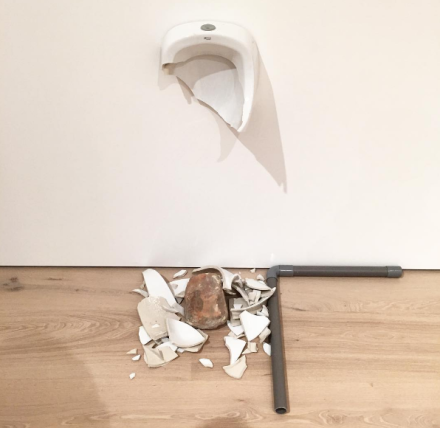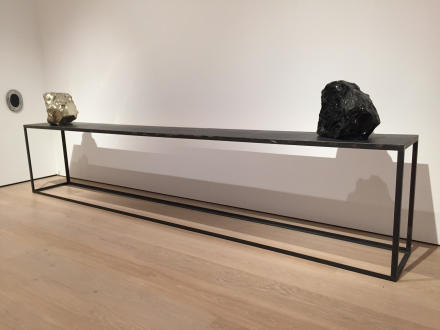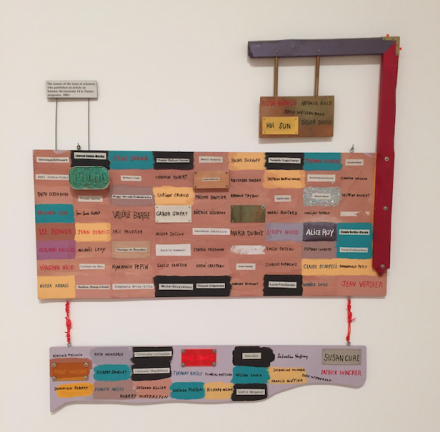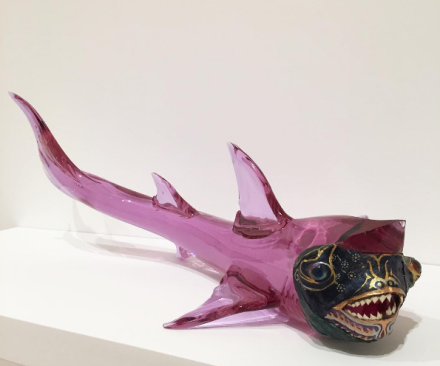
Jimmie Durham, At The Center of the World (Installation View), via Art Observed
For nearly fifty years, artist Jimmie Durham has worked at a unique junction of material and focus, exploring the modern world through his haphazard material sensibility.  Compiling works from broken planks of wood, reclaimed oil drums, signs, blown glass and other objects, the artist’s assemblages delve into the modern landscape, repositioning one’s perspective on the landscape of modernity, and the often challenging disconnects between human progress and the day to day world.  Currently presenting a survey of his work at the Hammer Museum in Los Angeles, the artist gives the viewer a moment to catch up to the times, bringing together a range of interests in history and politics that constantly undergird his approach to his work.

Jimmie Durham, Homage to David Hammons (1997), via Art Observed
Durham’s work is notable in its ability to blend form and function, always amplifying the material juxtapositions and ironies through his work’s titles and labels.  Pink Palm-Tree-Like Glass Construction with Various Decorative Elements, is just that, a range of both sculptural and natural elements twisted into a strangely compelling tower of scrap, and balanced atop a small wooden drawer.  Durham’s work emphasizes the object, but simultaneously draws distinctions of central objects and accompaniments throughout his pieces.  His works draw on the rupture of space caused by readymade materials or reclaimed parts, yet seem to seek to account for their presence.

Jimmie Durham, At The Center of the World (Installation View), via Art Observed
In other works, the artist’s subject matter clashes with materiality in more subtle modes.  In one piece, The Names of the the team of scientists who published an article on human chromosome 14 in Nature Magazine (2003), the artist presents his list of researchers in a rugged wood assemblage, a contrast with easy assumptions on the nature of modern tech or human health.  Delving into the thematics of an increasingly deep knowledge pool on human biology and function, his work turns this sense of the body back towards a simple materiality, creating a subtle conflict in expectations.  Durham’s works in this mode seem to reflect a sort of do-it-yourself history, building human progress in a manner that ties it closer to the human hand than to the advanced bio-tech making these achievements possible.

Jimmie Durham, Pink Palm-Tree-Like Glass Construction with Various Decorative Elements (2015), via Art Observed
The show also features a series of the artist’s video works, which have long accompanied his sculptures and provided a living counterpoint to many of his sculptural works.  His work Smashing, for instance, which sees the artist demolishing objects brought to his desk in a repetitive, comical take on modern bureaucracy, feels further animated by his piece Homage to David Hammons, which sees a smashed urinal placed alongside rocks and pipes.  Drawing on multiple threads and contexts within the pair of works, Durham’s pieces feel unified by action and image, allowing this shared gestural space to link together divergent histories and frameworks as a way to analyze each in conversation.

Jimmie Durham, The Names of the the team of scientists who published an article on human chromosome 14 in Nature Magazine (2003), via Art Observed
As a result, Durham’s work seems to celebrate both the human and the natural world in tandem, while managing to wittily poke holes in easy delineations between the two.  Drawing on moments that illustrate man’s place in the modern world, Durham seeks to break down and confuse the aesthetic assumptions of a future world, inserting his own sculptural sensibility to reframe and emphasize the place of human perception, and perhaps more importantly, human agency, in the modern world.
Durham’s work is on view through May 7th.

Jimmie Durham, Carnivalesque Shark in Venice (2015), via Art Observed
— D. Creahan
Read more:
Jimmie Durham:Â At the Center of the World [Hammer Museum]



